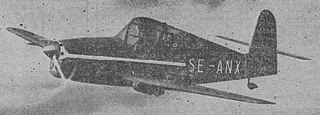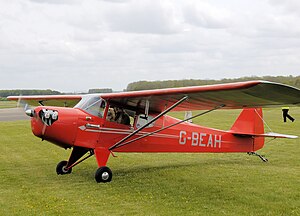The Aerauto PL.5C was a roadable aircraft developed in Italy in the early 1950s. It was a high-wing two-seat monoplane whose wings could be folded to quickly transform it into an automobile. It was different from many such projects in that it used its pusher propeller for propulsion not only in the air, but on the road as well. Development was abandoned in 1953.

The Beagle A.61 Terrier is a British single-engined monoplane built by Beagle Aircraft.
The Aeronca Model 9 Arrow was a low-wing all-metal cabin monoplane with retractable landing gear. It was marketed to returning pilots from World War II and unveiled in 1947 but never went into production.

The Auster J/1 Autocrat was a 1940s British single-engined three-seat high-wing touring monoplane built by Auster Aircraft Limited at Rearsby, Leicestershire.

The Auster J/4 was a 1940s British single-engined two-seat high-wing touring monoplane built by Auster Aircraft Limited at Rearsby, Leicestershire.

The Auster J/5 Aiglet Trainer was a 1950s British single-engined four-seat high-wing training and touring monoplane built by Auster Aircraft Limited at Rearsby, Leicestershire.

The Auster J/5 Alpine was a 1950s British single-engined four-seat high-wing training and touring monoplane built by Auster Aircraft Limited at Rearsby, Leicestershire.

The Auster J/1U Workmaster is a late 1950s British single-engined single-seat high-wing agricultural monoplane built by Auster Aircraft Limited at Rearsby, Leicestershire. Of traditional high-wing layout, it carries 90 gallons of spray fluid in a tank beside the pilot, an extra seat being provided for a passenger. The Lycoming 0-360-A engine of 180 h.p. driving a McCauley v.p. propeller giving it ample power; and slotted ailerons and balanced tail controls providing good handling. Oversize tyres were fitted. Take-off run at 2,550 lb gross weight and cruising speed at 65 per cent power are respectively 180 yd and 88 miles per hour (142 km/h). Britten-Norman spray gear was provided by Crop Culture, and this company ordered nine Workmasters.

The Auster D.4 was a two-seat British light aircraft, a development of the Auster Arrow with a horizontally opposed Lycoming engine, which originated from a Portuguese Air Force requirement for a liaison/training aircraft. Six were built by Auster Aircraft at their Rearsby, Leicestershire, factory, of which five went to Portugal, and nine more were built under licence in Portugal by the Oficinas Gerais de Material Aeronáutico OGMA from sets of components built by Auster and shipped from Rearsby. The original contract was for 25 sets of components but this was reduced in favour of the same number of additional Auster D5/160 sets.

The Piper PT-1 was a 1940s American two-seat primary training monoplane designed and built by Piper Aircraft at Lock Haven. A low-wing tandem two-seat monoplane, the PT-1 was the first Piper aircraft to have a low-wing. It had a fabric covering over an all-metal fuselage frame and wooden spar wings and tail unit. The PT-1 had a retractable tailwheel landing gear and was powered by a 130 hp (97 kW) Franklin 6AC-2980D engine. No further aircraft were built. A four-seat development was designed as the Piper PWA-6 which did not go into production either.

The Piaggio P.148 was a 1950s Italian two-seat primary or aerobatic training monoplane designed and built by Piaggio Aero.
The Fletcher FL-23 was an American two-seat liaison or observation aircraft designed and built by the California-based Fletcher Aviation Corporation. It was entered into a competition and lost against the Cessna 305A as a liaison or observation aircraft for the United States Army.

The SIAI-Marchetti SM.102 was a 1940s Italian light transport cabin monoplane designed and built by SIAI-Marchetti.
The Partenavia P.55 Tornado was a 1950s Italian high-performance competition and touring monoplane built by Partenavia. The Tornado was a small mid-wing cantilever monoplane with a retractable tricycle landing gear. The aircraft was powered by a nose-mounted Lycoming O-320 piston engine.

The Macchi MB.320 was an Italian cabin monoplane designed and built by Macchi. Only a small number were built.
The Taylorcraft Model 20 Ranch Wagon was a four-seat cabin monoplane designed and built by Taylorcraft Aircraft as a development of the earlier experimental Model 18. The Model 20 was constructed of moulded fibreglass over a tubular framework. It had a conventional landing gear and a nose-mounted 225 hp (168 kW) Continental O-470-J engine.
The Turbay T-1 Tucán was an Argentine single-engined single-seat light touring monoplane designed by Alfredo Turbay and built by Sociedad Anonima Sfreddo & Paolini. It first flew in April 1943.

The Skandinaviska Aero BHT-1 Beauty is a 1940s Swedish single-seat light monoplane designed by E. Bratt, K.E. Hilfing and B.Törnblom and built by Skandinaviska Aero of Stockholm.
The Viberti Musca 1 is a 1940s Italian two-seat civil touring monoplane produced by Ali Verberti SpA of Turin.
The Maestranza Central de Aviación Triciclo-Experimental was a prototype Chilean light aircraft of the 1940s.












